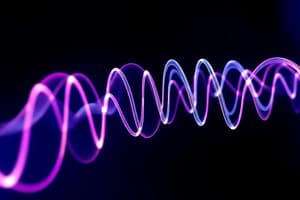Podcast
Questions and Answers
What is the primary reason microwaves are more effective for long-range communication compared to radiowaves?
What is the primary reason microwaves are more effective for long-range communication compared to radiowaves?
- Microwaves can penetrate buildings easily.
- Microwaves are less affected by atmospheric conditions.
- Microwaves can carry more data than radiowaves.
- Microwave wavelengths are significantly smaller than most objects. (correct)
Which of the following applications is NOT associated with infrared radiation?
Which of the following applications is NOT associated with infrared radiation?
- Haze photography
- Heating effects
- Remote sensing
- Photosynthesis (correct)
How do microwave ovens cook food so efficiently?
How do microwave ovens cook food so efficiently?
- They absorb all types of electromagnetic waves.
- They use high temperatures to cook food quickly.
- They resonate with the frequency of water molecules in food. (correct)
- They emit visible light to heat food directly.
What is a significant danger of ultraviolet (UV) radiation?
What is a significant danger of ultraviolet (UV) radiation?
Which of the following is an application of radio waves?
Which of the following is an application of radio waves?
What characteristic of microwaves allows them to avoid bending around obstacles?
What characteristic of microwaves allows them to avoid bending around obstacles?
Which application is NOT correctly paired with its corresponding part of the electromagnetic spectrum?
Which application is NOT correctly paired with its corresponding part of the electromagnetic spectrum?
What function does UV radiation serve in water purification?
What function does UV radiation serve in water purification?
What did James Clerk Maxwell predict about electromagnetic waves?
What did James Clerk Maxwell predict about electromagnetic waves?
What is necessary for a charge to radiate electromagnetic waves?
What is necessary for a charge to radiate electromagnetic waves?
How do the electric and magnetic fields behave in an electromagnetic wave?
How do the electric and magnetic fields behave in an electromagnetic wave?
Who first experimentally proved the existence of electromagnetic waves?
Who first experimentally proved the existence of electromagnetic waves?
What happens to the energy of an electromagnetic wave as it propagates through space?
What happens to the energy of an electromagnetic wave as it propagates through space?
What defines the frequency of an electromagnetic wave?
What defines the frequency of an electromagnetic wave?
What role does an oscillating charge play in creating electromagnetic waves?
What role does an oscillating charge play in creating electromagnetic waves?
In which direction do the electric field and magnetic field oscillate relative to each other in an electromagnetic wave?
In which direction do the electric field and magnetic field oscillate relative to each other in an electromagnetic wave?
What is the relationship between the amplitudes of electric and magnetic fields in an electromagnetic wave?
What is the relationship between the amplitudes of electric and magnetic fields in an electromagnetic wave?
What does the propagation constant 'k' represent in the equation of an electromagnetic wave?
What does the propagation constant 'k' represent in the equation of an electromagnetic wave?
Which characteristic is true about electromagnetic (EM) waves in vacuum?
Which characteristic is true about electromagnetic (EM) waves in vacuum?
What type of wave is an electromagnetic wave classified as?
What type of wave is an electromagnetic wave classified as?
What occurs to electromagnetic waves when they encounter electric or magnetic fields?
What occurs to electromagnetic waves when they encounter electric or magnetic fields?
What is the correct expression for the speed of propagation of an electromagnetic wave?
What is the correct expression for the speed of propagation of an electromagnetic wave?
How is the energy carried by electromagnetic waves shared between electric and magnetic fields?
How is the energy carried by electromagnetic waves shared between electric and magnetic fields?
What phenomenon is described as radiation pressure in electromagnetic waves?
What phenomenon is described as radiation pressure in electromagnetic waves?
What is the relationship between the speed of light (c), permittivity (ε0), and permeability (µ0)?
What is the relationship between the speed of light (c), permittivity (ε0), and permeability (µ0)?
What is the average energy density (u) of an electromagnetic wave expressed in terms of electric field strength (E0)?
What is the average energy density (u) of an electromagnetic wave expressed in terms of electric field strength (E0)?
What does the refractive index (n) of a material medium represent in relation to the electromagnetic wave speed?
What does the refractive index (n) of a material medium represent in relation to the electromagnetic wave speed?
What is the formula for calculating momentum (p) carried by an electromagnetic wave?
What is the formula for calculating momentum (p) carried by an electromagnetic wave?
In terms of energy crossing per unit area per unit time, how is intensity (I) defined?
In terms of energy crossing per unit area per unit time, how is intensity (I) defined?
What occurs when an electromagnetic wave falls on a perfectly absorbing surface in terms of momentum?
What occurs when an electromagnetic wave falls on a perfectly absorbing surface in terms of momentum?
How is the radiation pressure (Pr) exerted by an electromagnetic wave quantified?
How is the radiation pressure (Pr) exerted by an electromagnetic wave quantified?
What is the total energy density (u) of an electromagnetic wave composed of?
What is the total energy density (u) of an electromagnetic wave composed of?
Flashcards
Relation between c, ε₀, µ₀
Relation between c, ε₀, µ₀
The relationship shows c² = µ₀ε₀, where c is the speed of light.
Speed of EM wave in medium (v)
Speed of EM wave in medium (v)
v = c / √(µᵣ εᵣ) indicates speed in other materials compared to vacuum.
Refractive index (n)
Refractive index (n)
n = √(µᵣ εᵣ), it describes how light bends in different media.
Energy density (u) of EM wave
Energy density (u) of EM wave
Signup and view all the flashcards
Momentum (p) of EM wave
Momentum (p) of EM wave
Signup and view all the flashcards
Intensity (I) of EM wave
Intensity (I) of EM wave
Signup and view all the flashcards
Radiation pressure (Pᵣ)
Radiation pressure (Pᵣ)
Signup and view all the flashcards
Electromagnetic wave energy transfer
Electromagnetic wave energy transfer
Signup and view all the flashcards
Perpendicular fields
Perpendicular fields
Signup and view all the flashcards
Wave amplitude equations
Wave amplitude equations
Signup and view all the flashcards
Propagation constant
Propagation constant
Signup and view all the flashcards
Speed of EM waves
Speed of EM waves
Signup and view all the flashcards
Transverse nature
Transverse nature
Signup and view all the flashcards
Phase relationship
Phase relationship
Signup and view all the flashcards
Energy transport
Energy transport
Signup and view all the flashcards
Radiation pressure
Radiation pressure
Signup and view all the flashcards
Electromagnetic Spectrum
Electromagnetic Spectrum
Signup and view all the flashcards
Microwaves
Microwaves
Signup and view all the flashcards
Function of Microwave Oven
Function of Microwave Oven
Signup and view all the flashcards
Infrared Waves
Infrared Waves
Signup and view all the flashcards
Visible Light
Visible Light
Signup and view all the flashcards
Ultraviolet Light
Ultraviolet Light
Signup and view all the flashcards
Applications of Radio Waves
Applications of Radio Waves
Signup and view all the flashcards
Microwave Communication
Microwave Communication
Signup and view all the flashcards
Electromagnetic Waves
Electromagnetic Waves
Signup and view all the flashcards
Maxwell's Prediction
Maxwell's Prediction
Signup and view all the flashcards
Faraday's Law
Faraday's Law
Signup and view all the flashcards
Oscillating Charge
Oscillating Charge
Signup and view all the flashcards
Hertz's Experiment
Hertz's Experiment
Signup and view all the flashcards
Bose and Marconi
Bose and Marconi
Signup and view all the flashcards
Properties of EM Waves
Properties of EM Waves
Signup and view all the flashcards
Frequency of EM Waves
Frequency of EM Waves
Signup and view all the flashcards
Study Notes
Electromagnetic Waves
- James Clerk Maxwell predicted electromagnetic waves in 1865.
- Time-varying magnetic fields create changing electric fields, and vice-versa.
- Accelerating charges generate electromagnetic waves.
Source of EM Waves
- Stationary charges produce static electric fields.
- Moving charges at constant velocity produce magnetic fields that do not vary with time.
- Accelerating charges radiate electromagnetic waves.
Existence of EM Waves
- Heinrich Hertz experimentally proved the existence of EM waves.
- Jagdish Chandra Bose also produced and observed EM waves.
- Guglielmo Marconi transmitted EM waves over long distances.
Mathematical Expression of EM Waves
- EM waves propagate as coupled electric and magnetic fields perpendicular to each other and the direction of propagation.
- Electric (Ex) and magnetic (By) fields vary sinusoidally with time and position.
- The speed of EM waves in a vacuum is the speed of light (c = 3 x 10⁸ m/s).
Properties of EM Waves
- Created by accelerating charges.
- Transverse waves (electric and magnetic fields are perpendicular to each other and the direction of propagation).
- Do not require a medium to propagate; they can travel through a vacuum.
- Travel at the speed of light in a vacuum.
- Electric and magnetic fields oscillate in phase.
- The ratio of electric to magnetic field amplitudes is equal to c.
- Carry energy and momentum.
- Not deflected by electric or magnetic fields.
Relation between c, ε₀, and μ₀
- c = 1/√(μ₀ε₀) (where c is the speed of light, μ₀ is the permeability of free space, and ε₀ is the permittivity of free space).
Energy and Momentum of EM Waves
- The energy density (u) = (1/2)ε₀E₀² + (1/2)μ₀B₀²
- The momentum is U/c, where U is the total energy.
Intensity (I)
- Energy crossing per unit area per unit time perpendicular to the direction of propagation.
- I = U/(A*t) = uc
Radiation Pressure (Pr)
- Pressure exerted by EM waves on a surface.
- Pr=I/c
Electromagnetic Spectrum
- An orderly distribution of EM waves based on wavelength/frequency.
- Includes radio, microwaves, infrared, visible light, ultraviolet, X-rays, and gamma rays.
- Each type has distinct production and detection methods.
Applications of EM Spectrum
- Radio waves: Radio and television broadcasting, radio astronomy
- Microwaves: Radar, communication, microwave ovens
- Infrared: Heating effects, remote sensing
- Visible light: Observation, photosynthesis
- Ultraviolet: Food preservation, forgery detection
- X-rays: Medical diagnosis, crystallography
- Gamma rays: Cancer treatment, nuclear reactions, atomic nuclei study
Studying That Suits You
Use AI to generate personalized quizzes and flashcards to suit your learning preferences.




